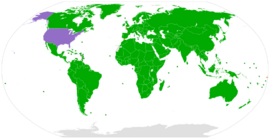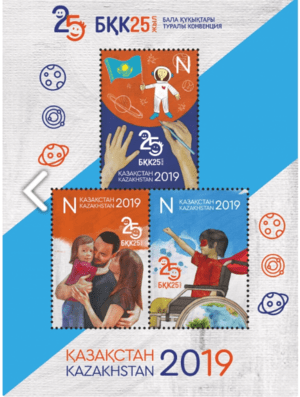Convention on the Rights of the Child facts for kids

Parties to the convention
Signed, but not ratified Non-signatory |
|
| Signed | 20 November 1989 |
|---|---|
| Location | New York City |
| Effective | 2 September 1990 |
| Condition | 20 ratifications |
| Signatories | 140 |
| Parties | 196 (all eligible states except the United States) |
| Depositary | UN Secretary-General |
| Languages | Arabic, Chinese, English, French, Russian, Spanish |
The United Nations Convention on the Rights of the Child (commonly abbreviated as the CRC or UNCRC) is an international human rights treaty which sets out the civil, political, economic, social, health and cultural rights of children. The convention defines a child as any human being under the age of eighteen, unless the age of majority is attained earlier under national legislation.
Nations that have ratified this convention or have acceded to it are bound by international law. When a state has signed the treaty but not ratified it, it is not yet bound by the treaty's provisions but is already obliged to not act contrary to its purpose.
The UN Committee on the Rights of the Child, composed of 18 independent experts, is responsible for supervising the implementation of the convention by the states that have ratified it. Their governments are required to report to and appear before the UN Committee on the Rights of the Child periodically to be examined on their progress regarding the advancement of the implementation of the convention and the status of child rights in their country. Their reports and the committee's written views and concerns are available on the committee's website.
Individuals can appeal to the Committee on the Rights of the Child if they believe that rights, according to the convention, have been violated. The third possibility for monitoring the implementation of the convention is inquiries that the Committee on the Rights of the Child can carry out on their own initiative if they have reliable information that leads them to believe that a member state has violated the convention's rights. However, "states ... may opt-out from the inquiry procedure, at the time of signature or ratification or accession". Once a year, the committee submits a report to the Third Committee of the United Nations General Assembly, which also hears a statement from the CRC Chair, and the Assembly adopts a Resolution on the Rights of the Child.
The UN General Assembly adopted the convention and opened it for signature on 20 November 1989 (the 30th anniversary of its Declaration of the Rights of the Child). It came into force on 2 September 1990, after it was ratified by the required number of nations. As of 26 April 2025, 196 countries are party to it, including every member of the United Nations except the United States.
Contents

The convention deals with child-specific needs and rights. It requires that the "nations that ratify this convention are bound to it by international law." Ratifying states must act in the best interests of the child.
In all jurisdictions implementing the convention requires compliance with child custody and guardianship laws as every child has basic rights, including the right to life, to their own name and identity, to be raised by their parents within a family or cultural grouping, and to have a relationship with both parents, even if they are separated.
The convention obliges states to allow parents to exercise their parental responsibilities. The convention also acknowledges that children have the right to express their opinions and to have those opinions heard and acted upon when appropriate, to be protected from abuse or exploitation, and to have their privacy protected. It requires that their lives not be subject to excessive interference.
The convention also obliges signatory states to separate legal representation for a child in any judicial dispute concerning their care and asks that the child's viewpoint be heard in such cases.
The convention forbids capital punishment for children. In its General Comment 8 (2006) the committee stated that there was an "obligation of all state parties to move quickly to prohibit and eliminate all corporal punishment and all other cruel or degrading forms of punishment of children". Article 19 of the convention states that state parties must "take all appropriate legislative, administrative, social and educational measures to protect the child from all forms of physical or mental violence", but it makes no reference to corporal punishment. The committee's interpretation of this section to encompass a prohibition on corporal punishment has been rejected by several state parties to the convention, including Australia, Canada and the United Kingdom.
The European Court of Human Rights has referred to the convention when interpreting the European Convention on Human Rights.
States party and signatories
The term "party" refers to a State that gives its explicit consent to be bound by the treaty.
As of 12 July 2022, 196 countries are parties to the UNCRC treaty (some with stated reservations or interpretations). Every member of the United Nations except the United States has either ratified or accepted the rights articulated for the child under eighteen or below the age of majority in that state. The most recent ratifications of the convention were by Cook Islands, Niue, the State of Palestine, and the Holy See.
See also
 In Spanish: Convención sobre los Derechos del Niño para niños
In Spanish: Convención sobre los Derechos del Niño para niños

